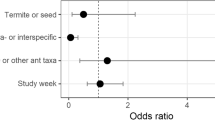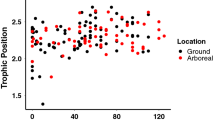Abstract
Ant-hemipteran mutualisms are widespread interactions in terrestrial food webs with far-reaching consequences for arthropod communities. Several hypotheses address the behavioral mechanisms driving the impacts of this mutualism, but relatively few studies have considered multiple ant species simultaneously as well as interspecific and intraspecific variation in ant behavior. In a series of field experiments that manipulated ant diet, this work examines the role of induced behaviors of forest ant species actively engaged in mutualism with Hemiptera. Based on other work in ant mutualisms, we predicted a higher frequency of aggressive behaviors towards prey and competitors by ants in the presence of honeydew-producing Hemiptera. We specifically compared Camponotus chromaoides and Formica neogagates (Formicidae), two abundant species in temperate forests of the northeastern U.S.A. After manipulating ant diet and interactions with sap-feeders experimentally, we observed 494 one-on-one interactions between ants and competitors, ladybird beetles and caterpillar prey. We found that C. chromaoides, exhibited behavioral dominance over F. neogagates, and C. chromaoides was more likely to attack ladybird beetles, competing ants, and caterpillar prey. However, contrary to other work in ant-Hemipteran mutualisms, we observed no evidence that food rewards provided by sap-feeders induced changes in ant behavior for either ant species examined. These results reveal the importance of considering interspecific differences in behavior as a mechanism underlying the ecological impacts of ant-Hemipteran protection mutualisms.




Similar content being viewed by others
References
Afkhami ME, Rudgers JA, Stachowicz JJ (2014) Multiple mutualist effects: conflict and synergy in multispecies mutualisms. Ecology 95:833–844
Agrawal AA, Ackerly DD, Adler F (2007) Filling key gaps in population and community ecology. Front Ecol Environ 5:145–152
Barton BT, Ives AR (2014) Direct and indirect effects of warming on aphids, their predators, and ant mutualists. Ecology 95:1479–1484
Bascompte J, Jordano P (2007) Plant-animal mutualistic networks: the architecture of biodiversity. Annu Rev Ecol Evol Syst 38:567–593
Bates D, Maechler M, Bolker B, Walker S (2015) Fitting linear mixed-effects models using lme4. J Stat Softw 67:1–48
Bronstein JL (2015) Mutualism. Oxford University Press, Oxford
Buczkowski G, Bennett GW (2008) Aggressive interactions between the introduced argentine ant, Linepithema humile and the native odorous house ant, Tapinoma sessile. Biol Invasions 10:1001–1011
Chamberlain SA, Holland JN (2009) Quantitative synthesis of context dependency in ant-plant protection mutualisms. Ecology 90:2384–2392
Chamberlain SA, Bronstein JL, Rudgers JA (2014) How context-dependent are species interactions? Ecol Lett 17:881–890
Cheng S, Zeng L, Xu Y (2015) Mutualism between fire ants and mealybugs reduces lady beetle predation. J Econ Entomol 108:1560–1569
Christensen KL, Gallacher AP, Martin L, Tong D, Elgar MA (2010) Nutrient compensatory foraging in a free-living social insect. Naturwissenschaften 97:941–944
Clark RE, Singer MS (2018) Keystone mutualism strengthens top–down effects by recruiting large-bodied ants. Oecologia 186(3):601–610
Clark RE, Farkas TE, Lichter-Marck I, Johnson ER, Singer MS (2016) Multiple interaction types determine the impact of ant predation of caterpillars in a forest community. Ecology 97(12):3379–3388
Davidson DW (1998) Resource discovery versus resource domination in ants: a functional mechanism for breaking the trade-off. Ecol Entomol 23:484–490
Dejean A, Bourgoin T, Gibernau M (1997) Ant species that protect figs against other ants: result of territoriality induced by a mutualistic homopteran. Écoscience 4:446–453
Detrain C, Verheggen FJ, Diez L, Wathelet B, Haubruge E (2010) Aphid-ant mutualism: how honeydew sugars influence the behavior of ant scouts. Physiol Entomol 35:168–174
Ellison AM, Gotelli NJ, Farnsworth EJ, Alpert GD (2012) A field guide to the ants of New England. Yale University Press, New Haven
Fox J, Weisberg S (2011) An R companion to applied regression, Second edn. Sage, Thousands Oaks
Grover CD, Kay AD, Monson JA (2007) Linking nutrition and behavioural dominance: carbohydrate scarcity limits aggression and activity in argentine ants. Proc R Soc B Biol Sci 274:2951–2957
Hood WM, Horton PM, McCreadie JW (2003) Field evaluation of the red imported fire ant (Hymenoptera : Formicidae) for the control of wax moths (Lepidoptera : Pyralidae) in stored honey bee comb. J Agr Urban Entomol 20:93–103
Kaplan I, Eubanks MD (2005) Aphids alter the community-wide impact of fire ants. Ecology 86:1640–1649
Kay AD, Zumbusch T, Heinen JL, Marsh TC, Holway DA (2010) Nutrition and interference competition have interactive effects on the behavior and performance of argentine ants. Ecology 91:57–64
Lach L, Parr CL, Abbott KL (2010) Ant ecology. Oxford University Press, Oxford
Langsrud Ø (2003) ANOVA for unbalanced data: use type II instead of type III sums of squares. Stat Comput 13:163–167
Lenth RV (2016) Least-squares means: the R package lsmeans. J Stat Softw 69:1–33
McGlynn TP, Parra EL (2016) Mechanisms of carbohydrate-fuelled ecological dominance in a tropical rainforest canopy-foraging ant. Ecol Entomol 41:226–230
Mooney KA, Mandal K (2010) Competition hierarchies among ants and predation by birds jointly determine the strength of multi-species ant–aphid mutualisms. Oikos 119:874–882
Morales MA, Barone JL, Henry CS (2008) Acoustic alarm signaling facilitates predator protection of treehoppers by mutualist ant bodyguards. Proc R Soc B Biol Sci 275:1935–1941
Ness JH, Morris WF, Bronstein JL (2009) For ant-protected plants, the best defense is a hungry offense. Ecology 90:2823–2831
Oliver TH, Leather SR, Cook JM (2008) Macroevolutionary patterns in the origin of mutualisms involving ants. J Evol Biol 21:1597–1608
Palmer TM, Doak DF, Stanton ML, Bronstein JL, Kiers ET, Young TP, Goheen JR, Pringle RM (2010) Synergy of multiple partners, including freeloaders, increases host fitness in a multispecies mutualism. Proc Natl Acad Sci U S A 107:17234–17239
Petry WK, Perry KI, Mooney KA (2012) Influence of macronutrient imbalance on native ant foraging and interspecific interactions in the field. Ecol Entomol 37:175–183
Phillips ID, Willis CKR (2005) Defensive behavior of ants in a mutualistic relationship with aphids. Behav Ecol Sociobiol 59:321–325
Pringle EG, Gordon DM (2013) Protection mutualisms and the community: geographic variation in an ant-plant symbiosis and the consequences for herbivores. Sociobiology 60:242–251
R Core Team. (2017) R: A language and environment for statistical computing. R Foundation for Statistical Computing, Vienna, Austria http://www.R-project.org/
Rosumek FB, Silveira FAO, de S Neves F et al (2009) Ants on plants: a meta-analysis of the role of ants as plant biotic defenses. Oecologia 160:537–549
Roulston TH, Buczkowski G, Silverman J (2003) Nestmate discrimination in ants: effect of bioassay on aggressive behavior. Insect Soc 50:151–159
Rudolph KP, Palmer TM (2013) Carbohydrate as fuel for foraging, resource defense and colony growth - a long-term experiment with the plant-ant Crematogaster nigriceps. Biotropica 45:620–627
Sanders NJ, Gotelli NJ, Wittman SE, Ratchford JS, Ellison AM, Jules ES (2007) Assembly rules of ground-foraging ant assemblages are contingent on disturbance, habitat and spatial scale. J Biogeogr 34:1632–1641
Shik JZ, Silverman J (2013) Towards a nutritional ecology of invasive establishment: aphid mutualists provide better fuel for incipient argentine ant colonies than insect prey. Biol Invasions 15:829–836
Shik JZ, Kay AD, Silverman J (2014) Aphid honeydew provides a nutritionally balanced resource for incipient argentine ant mutualists. Anim Behav 95:33–39
Singer MS, Johnson ER, Lichter-Marck IH, Clark RE, Mooney KA (2017) Predatory birds and ants partition caterpillar prey based on caterpillar body size and diet breadth. J Anim Ecol 86:1363–1371
Stadler BA, Dixon FG (2008) Mutualism: ants and their insect partners. Cambridge University Press, Cambridge
Stanton ML (2003) Interacting guilds: moving beyond the pairwise perspective on mutualisms. Am Nat 162:S10–S23
Stenberg JA, Lehrman A, Bjorkman C (2011) Plant defence: feeding your bodyguards can be counter-productive. Basic Appl Ecol 12:629–633
Stuble KL, Rodriguez-Cabal MA, McCormick GL, Juric I, Dunn RR (2013) Tradeoffs, competition, and coexistence in eastern deciduous forest ant communities. Oecologia 171:981–992
Styrsky JD, Eubanks MD (2007) Ecological consequences of interactions between ants and honeydew-producing insects. Proc Biol Sci 274:151–164
Styrsky JD, Eubanks MD (2010) A facultative mutualism between aphids and an invasive ant increases plant reproduction. Ecol Entomol 35:190–199
Suarez AV, Holway DA, Liang D, Tsutsui ND, Case TJ (2002) Spatiotemporal patterns of intraspecific aggression in the invasive argentine ant. Anim Behav 64:697–708
Wilder SM, Eubanks MD (2010) Extrafloral nectar content alters foraging preferences of a predatory ant. Biol Lett 6:177–179
Wilder SM, Barnum TR, Holway DA, Suarez AV, Eubanks MD (2013) Introduced fire ants can exclude native ants from critical mutualist-provided resources. Oecologia 172:197–205
Wills BD, Chong CD, Wilder SM, Eubanks MD, Holway DA, Suarez AV (2015) Effect of carbohydrate supplementation on investment into offspring number, size, and condition in a social insect. PLoS One 10(7):e0132440
Wimp GM, Whitham TG (2001) Biodiversity consequences of predation and host plant hybridization on an aphid–ant mutualism. Ecology 82:440–452
Yoo HJS, Kizner MC, Holway DA (2013) Ecological effects of multi-species, ant-hemipteran mutualisms in citrus: ecological effects of a multi-species mutualism. Ecol Entomol 38:505–514
Zhang YZ (2012) The ecological effects of the ant–hemipteran mutualism: a meta-analysis. Basic App Ecol 13:116–124
Acknowledgements
This work was supported by NSF Doctoral Dissertation Improvement Grant DEB-1404177. Fieldwork components of this project could not have been completed without the help of Henok Alemu, Mattheau Comerford, Taiga Araki, Maxwell Atkinson, Pierre Gerard, and Delaine Winn. We thank Sonia E. Sultan, Frederick M. Cohan, and Manuel A. Morales for helpful feedback in the design of these experiments. We also acknowledge the Singer lab group for their constructive comments on early versions of this manuscript.
Author information
Authors and Affiliations
Contributions
REC and MSS designed experiments and wrote and revised the manuscript. REC performed field experiments and analyzed data.
Corresponding author
Electronic supplementary material
ESM 1
(DOCX 5166 kb)
Rights and permissions
About this article
Cite this article
Clark, R.E., Singer, M.S. Differences in Aggressive Behaviors between Two Ant Species Determine the Ecological Consequences of a Facultative Food-for-Protection Mutualism. J Insect Behav 31, 510–522 (2018). https://doi.org/10.1007/s10905-018-9695-8
Received:
Revised:
Accepted:
Published:
Issue Date:
DOI: https://doi.org/10.1007/s10905-018-9695-8




